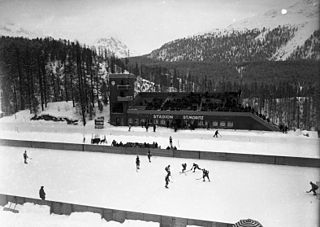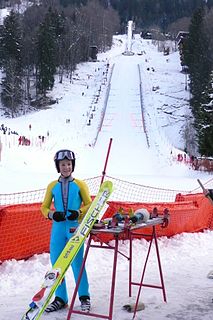
Olympiaschanze was a ski jumping venue in St. Moritz, Switzerland, it was built in 1926 and closed in 2006. The ski jumping and the ski jumping part of the Nordic combined event for the 1928 Winter Olympics.
Its K-point was 66 m.

Olympiaschanze was a ski jumping venue in St. Moritz, Switzerland, it was built in 1926 and closed in 2006. The ski jumping and the ski jumping part of the Nordic combined event for the 1928 Winter Olympics.
Its K-point was 66 m.

The 1928 Winter Olympics, officially known as the II Olympic Winter Games, were a winter multi-sport event which was celebrated February 11–19, 1928 in St. Moritz, Switzerland.

The 1924 Winter Olympics, officially known as the I Olympic Winter Games, were a winter multi-sport event which was held in 1924 in Chamonix, France. Originally held in association with the 1924 Summer Olympics, the sports competitions were held at the foot of Mont Blanc in Chamonix, and Haute-Savoie, France between January 25 and February 5, 1924. The Games were organized by the French Olympic Committee, and were originally reckoned as the "International Winter Sports Week." With the success of the event, it was retroactively designated by the International Olympic Committee (IOC) as the I Olympic Winter Games.

The 1932 Winter Olympics, officially known as the III Olympic Winter Games, were a winter multi-sport event in the United States, held in Lake Placid, New York. The games opened on February 4 and closed on February 15. It was the first of four Winter Olympics held in the United States; Lake Placid hosted again in 1980.

Pragelato is a comune (municipality) in the Metropolitan City of Turin in the Italian region Piedmont, located about 60 kilometres (37 mi) west of Turin, in the upper Val Chisone. The name Pragelato, meaning "icy meadow", has been derived from the harsh climate and the fact that the ground is covered with ice for long periods. On both sides of the Chisone, extensive forests of pine and larch provide protection from the avalanches which are a common occurrence in the winter season: for this reason in the nineteenth century the people of Pragelato were only permitted to fell trees close to the mountain summits, and even then only with the permission of the communal administration.

St. Moritz Olympic Ice Rink is an outdoor stadium in St. Moritz, Switzerland. It was the venue for the ice hockey, speedskating and figure skating events, as well as the location of the opening and closing ceremonies at the 1928 Winter Olympics and 1948 Winter Olympics.

The Große Olympiaschanze is a ski jumping hill located on the Gudiberg, south of the district of Partenkirchen of Garmisch-Partenkirchen, Bavaria, Germany, and is traditionally the venue of the Four Hills Tournament's New Year's jumping.

The Lake Placid Olympic Ski Jumping Complex comprises a 90- and 120-meter ski jumps towers built for the 1980 Olympic Games in Lake Placid, New York, United States. They are located two miles from Lake Placid, off the Old Military Road, in Essex County, New York. The complex is operated by the Olympic Regional Development Authority.

Stadio del Trampolino is a ski jumping hill located in Pragelato, Italy. During the 2006 Winter Olympics, it hosted the ski jumping and the ski jumping part of the Nordic combined events. It also hosted FIS Ski Jumping World Cup events in the 2004–05 and 2008–09 seasons.

Le Tremplin Olympique du Mont was a ski jumping venue constructed for the 1924 Winter Olympics in Chamonix, France.
For the 1928 Winter Olympics in St. Moritz, Switzerland, a total of five sports venues were used. The main stadium hosted the figure skating, ice hockey, and speed skating events. Skeleton was first held at the Cresta Run. Bobsleigh was held at the bob run. St. Moritz itself served as cross-country skiing venue and the cross-country part of the Nordic combined event. Weather gave two events run at these games problems, creating the largest margin of victory in Olympic history for one and the cancellation of the other.
For the 1948 Winter Olympics in St. Moritz, Switzerland, a total of eight sports venues were used. The five venues used for the 1928 Winter Olympics were reused for these games. Three new venues were added for alpine skiing which had been added to the Winter Olympics program twelve years earlier in Garmisch-Partenkirchen, Germany. As of 2015, the bob run continues to be used for bobsleigh and the Cresta Run for skeleton while alpine skiing remains popular in St. Moritz.
For the 1964 Winter Olympics in Innsbruck, Austria, a total of eight sports venues were used. Luge made its debut at these games, but were marred by the death of a British slider two weeks prior to the Games. A second ski jumping event debuted and the best two out of three jumps were used in both events for the only time in the history of the Winter Olympics. All eight venues would be used again when the Winter Games returned to Innsbruck twelve years later though the venues would undergo renovations in time for the 1976 Games.
For the 1972 Winter Olympics in Sapporo, Japan, a total of twelve sports venues were used. A thirteenth venue which was a reserved luge course was constructed, but never used in actual competition. Construction on all but of the venues used took place between 1968 and early 1971 in time for the test events. The Tsuskisamu Indoor Skating Rink was not completed until late 1971 or early 1972 because the number of teams scheduled to compete at the 1972 Games was not known. At the actual luge venue used, a malfunctioning starting gate during the first run led to the results being cancelled and rerun being ordered. The results of this event led to the only tie in Olympic luge history. The ski jumps at Miyanomori and Okurayama served as host venues for the FIS Nordic World Ski Championships thirty-five years later.

For the 1980 Winter Olympics in Lake Placid, New York, United States, a total of seven sports venues were used. All five of the venues used for the 1932 Winter Olympics were also used at the 1980 Winter Games with adjustments. These adjustments included electronic scoreboards, increased refrigeration, and the addition of a separate luge track. This was the last Winter Olympics where there were separate bobsleigh and luge tracks. The closest finish in Olympic history in cross-country skiing led skiing officials to time future events in hundredths of a second rather than tenths of a second. This would also apply to biathlon events. Eric Heiden of the United States won five gold medals at the speed skating oval while the "Miracle on Ice" took place between Americans and Soviets at the Olympic Center. In the late 1990s, the luge track was demolished and a new combination track was constructed in time for the only Winter Goodwill Games held. The sliding venue was named to the American National Register of Historical Places in February 2010.

For the 1998 Winter Olympics in Nagano, Japan, a total of fifteen sports venues were used. Nagano had attempted twice to host the Winter Olympics, losing out to Sapporo, host of the 1972 Winter Olympics. The third time, in 1991, Nagano edged out Salt Lake City to host the 1998 Games. The biathlon venue was adjusted in accordance with the Washington Convention over endangered species. The biggest venue controversy was at Happo'one resort on the length of the men's downhill and the battle that ensued to the point where skiing officials threatened to pull the event entirely before a compromise was reached three months before the Olympics. M-Wave has hosted three World Speed Skating Championships since the Olympics while the Spiral has hosted a couple of World championships in bobsleigh, luge, and skeleton.
Coordinates: 46°28′31″N9°49′27″E / 46.475182°N 9.824156°E
| This article about a Swiss sports venue is a stub. You can help Wikipedia by expanding it. |
| This article about a ski jumping venue is a stub. You can help Wikipedia by expanding it. |
| This about a Winter Olympics venue article is a stub. You can help Wikipedia by expanding it. |